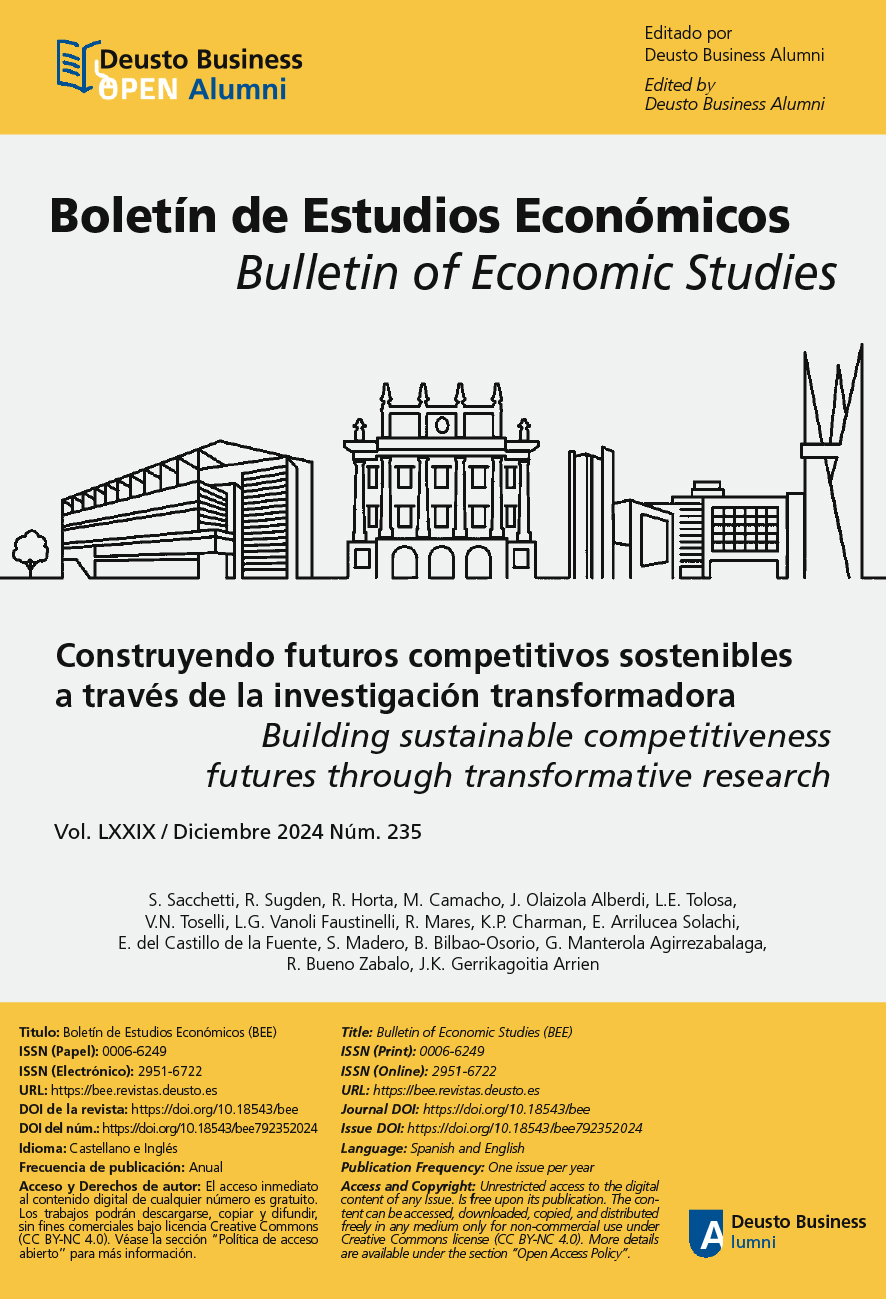The productive matrix as a basis for the territorial development strategy. case province of Córdoba (Argentina)
Abstract
The establishment of the Competitiveness Center at the Catholic University of Córdoba, coupled with the interdisciplinary team’s efforts it spearheaded, stands as a prime example of how universities and their affiliated institutes serve as catalysts and contribute to the cocreation of a competitive and sustainable environment, as well as to the formulation of public policies.
This endeavor elucidates the research, discussion, and tool construction process for policy design, focusing particularly on the productive matrix of the province of Córdoba. It entailed adapting internationally renowned methodologies to the local context, thereby surmounting challenges inherent in collaboration among the government, academia, and the private sector.
Drawing inspiration from the Basque Country’s experience and methodological underpinnings of the U.S. Cluster Mapping, the collaborative construction of the matrix incorporated environmental and social dimensions alongside traditional economic aspects. Noteworthy achievements include the identification of local and exporting clusters (Traded and Local Clusters), the province’s inaugural cluster mapping, and laying the groundwork for the Provincial Industrial Promotion Law, presently in force.
References
Aragón, C., Aranguren, M.J., Iturrioz, C., & Wilson, J.R. (2014). A social capital approach for network policy learning: the case of an established cluster initiative. European Urban and Regional Studies, 21(2), 128-145. https://doi.org/10.1177/0969776411434847
Aranguren, M.J., Canto-Farachala, P, & Wilson, J.R. (2021). Transformative academic institutions: An experimental framework for understanding regional impacts of research. Research Evaluation, 30(2), 191-200. https://doi.org/10.1093/reseval/rvaa030
Aranguren, M.J., de la Maza, X., Parrilli, M.D., & Wilson, J.R. (2009). Asociaciones clúster de la CAPV: desempeño y retos. Orkestra-Instituto Vasco de Competitividad. Disponible en https://www.researchgate.net/publication/262522921_Asociaciones_Cluster_de_la_CAPV_Desempeno_y_retos
Aranguren, M.J., Larrea, M., & Wilson, J.R. (2012). Academia and public policy: Towards de co-generation of knowledge and learning processes. In B.T. Asheim & M.D. Parrilli (Eds.), Interactive Learning for Innovation. London: Palgrave Macmillan. https://doi.org/10.1057/9780230362420_12
Audretsch, D.B., Menéndez, H., Richardson, A. & Mamtora, A. (2017).The strategic management of places and regional competitiveness. In Huggins, R. & Thompson, P. (Eds), Handbook of Regions and Competitiveness. Contemporary Theories and Perspectives on Economic Development. Edward Elgar Publishing.
Braña, F., Domínguez, R., & León, M. (2016). Buen Vivir y cambio de la matriz productiva. Quito: FES-ILDIS. Disponible en https://library.fes.de/pdf-files/bueros/quito/12781.pdf
Canto, P., Costamagna, P., Eizagirre, A., & Larrea, M. (2018). Los retos de la co-generación en la búsqueda del impacto social de la universidad: un caso de construcción de un espacio dialógico a través de la investigación acción. European Public & Social Innovation Review, 3(1), 46-67. https://doi.org/10.31637/epsir.18-1.5
CEPAL, P. (2020) El futuro de la matriz productiva argentina: consensos y nuevas perspectivas. Disponible en https://www.argentina.gob.ar/sites/default/files/futuros_de_la_matriz_productiva_editado.pdf
Executive Office of the President Office of Management and Budget. (2022). North American Industry Classification System (NAICS). Disponible en https://www.argentina.gob.ar/sites/default/files/futuros_de_la_matriz_productiva_editado.pdf
Fortín, M. T., González, M., & Productivo, D. (2022). Manual de capacitación 2: Diversificación productiva. Disponible en https://repositorio.iica.int/handle/11324/20744
Gibbons, M., Limoges, C., Nowotny, H., Schwartzman, S., Scott, P., & Trow, M. (1997). La nueva producción del conocimiento. La dinámica de la ciencia y la investigación en las sociedades contemporáneas. Barcelona: Pomares-Corredor.
Goenaga et al. (2021). Gobernanza multinivel y multiactor para la resiliencia territorial: el caso de Gipuzkoa y las comarcas de Debabarrena, Goierri y Urola Erdia. Dossieres EsF, 40. Invierno 2021.
Hirschman, A.O. (1998). Backward and Forward Linkages. The New Palgrave: A Dictionary of Economics. Palgrave Publishers.
Huggins, R. & Thompson, P. (2017). Introducing regional competitiveness and development: Contemporary theories and perspectives. In R. Huggins & P. Thompson (Eds.), Handbook of regions and competitiveness, Cheltenham, UK and Northampton, MA, USA: Edward Elgar. Disponible en https://ideas.repec.org/h/elg/eechap/15784_1.html
INDEC. (2010). Clasificación Nacional de Actividades Económicas (CLANAE) de Argentina.
Laredo, P. (2007). Revisiting the third mission of universities: Toward a renewed categorization of university activities?. Higher Education Policy, 20(4), 441–456. Disponible en https://paginas.fe.up.pt/~sfeyo/Docs_SFA_Reitor/20070000_Laredo_THIRD_Mission.pdf
Karlsen, J., Larrea, M., Wilson, J.R., & Aranguren, M.J. (2012). Bridging the gap between academic research and regional development in the Basque Country. European Journal of Education, 47(1).
Navarro. (2014). El papel de los centros de formación profesional en los sistemas de innovación regionales y locales. Cuadernos Orkestra. 2014/7.
Palacios-Molina, D.L., & Reyes-Vélez, P.E. (2016). Cambio de la matriz productiva del Ecuador y su efecto en el comercio exterior. Dominio de las Ciencias, 2(2), 418-431. Disponible en https://dominiodelasciencias.com/ojs/index.php/es/article/view/183
Porter, M.E. (2011). Creating shared value. Harvard Business Review 89(1/2), 62-77.
Porter, M.E. (1990). The Competitive Advantage of Nations. New York, NY, USA: Free Press.
Villamil, J., & Hernández, G. (2016). Encadenamientos, clústeres y flujos de trabajo en la economía colombiana. Ensayos sobre Política Económica, 34(79), 51-65. Disponible en https://www.sciencedirect.com/science/article/abs/pii/S0120448316000063
Tsai, W. & Ghoshal. S. (1998) Social capital and value creation: The role of intrafirm networks. Academy of Management Journal 41(4), 464–476.
Copyright (c) 2025 Deusto Business Alumni

This work is licensed under a Creative Commons Attribution-NonCommercial 4.0 International License.
License:
Works published in this journal are available since 2021 under the Creative Commons Attribution-NonCommercial 4.0 International license - CC BY-NC 4.0. Content prior to 2021 is not covered by the journal's current Open Access policy.
Authors' Rights:
Authors retain copyright over their work published in the Bulletin of Economic Studies and grant the Bulletin of Economic Studies non-exclusive rights to exploit the work for layout, publication, and dissemination purposes. This license allows the Bulletin of Economic Studies to distribute, reproduce, and disseminate the work on its platform and through other media, subject to the conditions outlined in this notice.
Readers' Rights:
Readers may read, download, print, search, share (copy, redistribute, or link to full text), or adapt (remix, transform, and build upon the material) the content, provided that:
- The materials are not used for commercial purposes.
- The original work is properly cited, including the name of the author and the source.
- Any modifications made to the original content are clearly indicated.
Commercial use of the materials is prohibited without the express permission of the authors. For clarity, commercial use is defined as any activity intended for financial gain or involving direct commercial exchange.
Conditions of Use:
The use of content must not infringe the rights of others or be used in a way that could damage the reputation of the author or the Bulletin of Economic Studies.
Responsibility for Content:
Authors are responsible for the content of their papers and the Bulletin of Economic Studies is not responsible for the opinions therein expressed.
More Information:
Open Access, Licensing, and Copyright Policy


.jpg)
.jpg)
.jpg)








